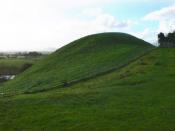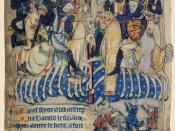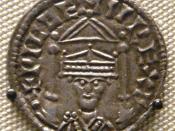Norman castles were built from the 11th to 13th centuries. Castles were brought to Britain by William the Conqueror, when he invaded England from his homeland in France. Known as the Duke of Normandy, William invaded England in 1066 and, due to his victory in the Battle of Hastings, William was crowned the King of England, and became King William I. One of the most powerful ways for William to take control of his new kingdom, which included England, Scotland and Wales, was to have castles built throughout the land.
At first, he ordered the construction of very simple castles, called motte and bailey castles. They consisted of an earthen mound, called a motte, topped by a tower (first built of wood, and soon rebuilt in stone to make the towers sturdier). The bailey was a large area of land enclosed by a shorter mound, placed next to the motte.
Inside the bailey were the main activities of the castle (workshops, stables and livestock, household activities, etc.), while the tower on the motte was used as the lord's residence and as an observation post. These earth and wood castles were not very sturdy, because the wood would rot fairly quickly and was easy for an enemy to burn. So, William the king ordered the construction of stone castles. Stone castles were much sturdier, did not rot like wood, and also were much more able to withstand any attack by an invader. Over the centuries after William was king, other kings ordered elaborate castles to be built. Castles were not just used by the king. Most castles, in fact, were granted by a king to their most loyal subjects, knights or barons who fought valiantly in battle and supported their king. The king, starting with William the Conqueror, gave...


